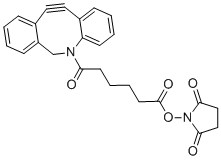
DBCO-NHS ester 2
CAS No. 1384870-47-6
DBCO-NHS ester 2( DBCO-C6-NHS ester )
Catalog No. M11599 CAS No. 1384870-47-6
DBCO-NHS ester 2 is a derivative of DBCO (Dibenzylcyclooctyne) used in Cu-free click chemistry.
Purity : >98% (HPLC)
 COA
COA
 Datasheet
Datasheet
 HNMR
HNMR
 HPLC
HPLC
 MSDS
MSDS
 Handing Instructions
Handing Instructions
| Size | Price / USD | Stock | Quantity |
| 100MG | Get Quote | Get Quote |


|
| 200MG | Get Quote | Get Quote |


|
| 500MG | Get Quote | Get Quote |


|
| 1G | Get Quote | Get Quote |


|
Biological Information
-
Product NameDBCO-NHS ester 2
-
NoteResearch use only, not for human use.
-
Brief DescriptionDBCO-NHS ester 2 is a derivative of DBCO (Dibenzylcyclooctyne) used in Cu-free click chemistry.
-
DescriptionDBCO-NHS ester 2 is a derivative of DBCO (Dibenzylcyclooctyne) used in Cu-free click chemistry; is useful in strain-promoted copper-free azide-alkyne cycloaddition reactions; used in DNA-assisted protein analysis such as proximity ligation and extention assays, antibody drug conjugates.
-
In Vitro——
-
In Vivo——
-
SynonymsDBCO-C6-NHS ester
-
PathwayAntibody Drug Conjugates (ADC)
-
TargetADCs Linker/Click Chemistry
-
RecptorADCs Linker/Click Chemistry
-
Research Area——
-
Indication——
Chemical Information
-
CAS Number1384870-47-6
-
Formula Weight430.45
-
Molecular FormulaC25H22N2O5
-
Purity>98% (HPLC)
-
SolubilityIn Vitro:?DMSO : 14.29 mg/mL (33.20 mM)
-
SMILESO=C(CCCCC(ON1C(CCC1=O)=O)=O)N2CC3=C(C=CC=C3)C#CC4=C2C=CC=C4
-
Chemical Name2,5-Dioxo-1-pyrrolidinyl 11,12-didehydro-ε-oxodibenz[b,f]azocine-5(6H)-hexanoate
Shipping & Storage Information
-
Storage(-20℃)
-
ShippingWith Ice Pack
-
Stability≥ 2 years
Reference
1. Tang F, et al. Nat Protoc. 2017 Aug;12(8):1702-1721.
molnova catalog



related products
-
m-PEG12-amine
m-PEG12-amine is a PEG-based PROTAC linker and a non-cleavable 12-unit PEG ADC linker used in the synthesis of PROTACs and antibody-drug conjugates (ADCs) .
-
Fmoc-8-amino-3,6-dio...
Fmoc-8-amino-3,6-dioxaoctanoic acid is a cleavable ADC linker used in the synthesis of antibody-drug conjugates (ADCs).
-
DBCO-NHS ester
An amine-reactive NHS ester that provides easy attachment of the reactive moiety to almost any primary or secondary amine group, such as that of protein, peptide, or small molecule amine.



 Cart
Cart
 sales@molnova.com
sales@molnova.com


